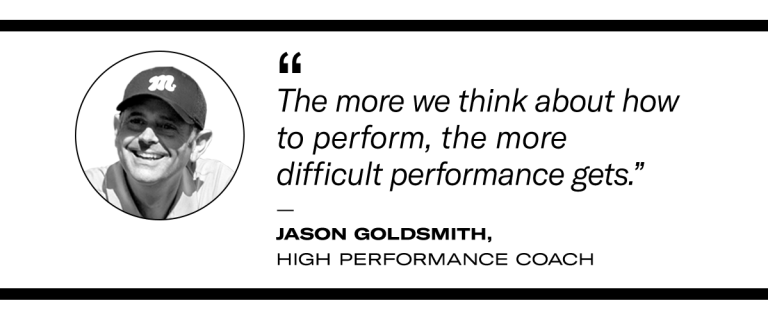Performance guru Jason Goldsmith offers his advice to reduce stress, hit better shots, and have more fun.

“Don’t let the thinking get in the way of the doing.”
That’s a mantra globally-recognized performance coach Jason Goldsmith shares with all of his clients, from high-powered business executives to professional athletes across sports, including two former No. 1 professional golfers.
“The more we think about how to perform, the more difficult performance gets,” says Goldsmith. Of course, there is a time for practice, on the range and in lessons, during which you’ll be making adjustments to your swing mechanics and spend time thinking about how to implement those adjustments. But when it comes time to actually play golf, all of those thoughts should stay behind so you can swing freely. Goldsmith shares eight tips to master your mind so you can master your game.
Gather the Data
“Being presently connected to the environment is critical, and so is making a decision and committing to that decision,” Goldsmith says. To do that, you need to assess all available information: find your ball, identify your lie, get your yardage, check your wind. This is the physical part of your pre-shot routine. Once you pull the appropriate club from your bag, the mental part begins.
Visualize the Shot You Intend to Hit
With your chosen club in hand, visualize the arc of your shot. See it flying through the air, landing at the front of the green, and releasing to the hole. Commit to that intended shot before you address the ball. “The visualization gives your body the information it needs to perform that specific action,” Goldsmith says. “Then, you’re not standing over the ball, thinking about what you want it to do, because you’ve already done it.”
Don’t Be a Time Traveler
Bad shots happen, because golf is a difficult sport. But one bad shot often begets another, and another, because your mind gets involved with trying to fix the last shot to save you from the next. “That kind of time-traveling to the past and future is a recipe for frustration and struggle,” says Goldsmith. “If you’re thinking about playing, and operating from a place of fear and doubt, you’re not playing anymore, and that prevents you from being your most athletic self.” Anchor yourself to the present by relying on your pre-shot visualization routine.

Play Golf, Not the Golf Swing
Many golfers take multiple practice swings before their shot, thinking this will produce the shot they want, but Goldsmith says instead it is the shot you create in your mind first that produces the technique that allows that shot to happen. “People get stuck on the idea of a perfect, repeatable golf swing, but really, you want your swing to adapt to your intention, because no two golf shots are ever the same,” Goldsmith explains. Skill acquisition rarely happens mid-round, and Goldsmith says going out on the course with a hit-it-and-fix-it mindset will focus you too much on your swing to have good results.
Focus On Your Intended Target
Just as a shortstop’s focus is on the base they’re throwing to even while still in the process of fielding a ground ball, a golfer’s mental focus should be on the target even if their eyes are focused on the ball. “You need to be keenly aware of the shot you intend to hit, and you can’t do that if you’re hearing a dialogue in your head when you stand over the ball,” Goldsmith says. If you’re hearing voices giving you swing thoughts, you are internally focused and will likely hit a mediocre shot. Goldsmith recommends stepping away from the ball, re-imagining the shot you intend to hit with your focus externally located on the target, then stepping in and letting it rip.
Choose a Positive Attitude
Wind, rain, heat and other bad course conditions can sap your energy and compound your mistakes, but they don’t have to. “Fighting the weather is a choice, and you’re going to struggle and lose, because Mother Nature hasn’t lost yet,” Goldsmith says. It is better to choose to be the golfer who uses the wind rather than fights it, and has fun on a day when everyone’s scores will be higher than normal. Goldsmith recommends giving yourself mini-challenges, like playing three holes with the same ball, as a way to not let the circumstances dictate your attitude and to use obstacles as an opportunity for growth.
When in Doubt, Breathe
When you’re stressed out and unraveling on the golf course, take a few seconds to focus on a controlled inhale and exhale. “Taking a conscious breath is often enough to take you out of your own head,” Goldsmith says. “It brings you back to your present circumstances.” Goldsmith says this doesn’t have to be a complicated exercise of counted breaths or holds. It simply has to divert your attention from whatever negatively appreciating thoughts are running through your mind so you can refocus your attention on the shot you’re about to hit.
Most Importantly, Have Fun
Every golfer has experienced a day of social golf with friends, chatting from tee to green, when you suddenly realize toward the end of the round that you’re on pace for your best score yet. And then, you start to press, and your game falls apart. “Simply having fun with the game takes you out of your head and allows you to be your most athletic self and just play,” Goldsmith says. “When you play to protect the score, you’re back in your head, hamstrung by your fears and doubts.” Maintaining the mindset that golf is a game played for fun actually produces the best outcome.


